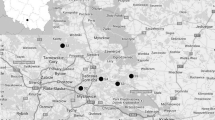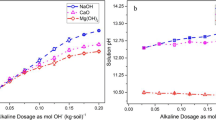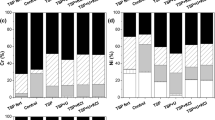Abstract
Immobilization of metals by two materials (zeolite, AZ, and a synthetic, carbonate-rich material, “slovakite”, SL) was tested in a pot experiment with two soils from urban areas of Sevilla and two soils affected by a mine spill. Barley (Hordeum vulgare L. Hispanic) was grown in the pots, and metal contents were measured after 31 days in shoots and roots. Available metal was estimated by extraction with CaCl2 (readily soluble), ethylenediaminetetraacetic acid (EDTA; plant available), a mixture of organic acids (soluble by root exudates), and glycine (bioaccessible by ingestion). Neither treatment caused significant differences on plant growth or metal contents of shoots, whereas roots contained more Cu in the SL treatments. Root Zn uptake was reduced in all cases, but reduction of Pb in roots was observed only in AZ treatments of the mine-spill soils. The effects on metal availability were often method-dependent. Decrease of CaCl2 data were observed only in the mine-spill soils. EDTA-soluble metals were clearly decreased by both materials. Bioaccessible Zn were decreased by either material in several cases (but not in the most heavily polluted soil), whereas Cu or Pb data were less conclusive.


Similar content being viewed by others
References
De Miguel, E., Iribarren, I., Chacón, E., Ordóñez, A., & Charlesworth, S. (2007). Risk-based evaluation of the exposure of children to trace elements in playgrounds in Madrid (Spain). Chemosphere, 66, 505–513. doi:10.1016/j.chemosphere.2006.05.065.
Ebbs, S. D., & Kochian, L. V. (1998). Phytoextraction of zinc by oat (Avena sativa), barley (Hordeum vulgare), and Indian mustard (Brassica juncea). Environmental Science & Technology, 32, 802–806. doi:10.1021/es970698p.
Feng, M. H., Shan, X. Q., Zhang, S., & Wen, B. (2005). A comparison of the rhizosphere-based method with DTPA, EDTA, CaCl2, and NaNO3 extraction methods for prediction of bioavailability of metals in soil to barley. Environmental Pollution, 137, 231–240. doi:10.1016/j.envpol.2005.02.003.
Garau, G., Castaldi, P., Santona, L., Deiana, P., & Melis, P. (2007). Influence of red mud, zeolite and lime on heavy metal immobilization, culturable heterotrophic microbial populations and enzyme activities in a contaminated soil. Geoderma, 142, 47–57. doi:10.1016/j.geoderma.2007.07.011.
Gee, G. W., & Bauder, J. W. (1986). Particle-size analysis. In A. Klute (Ed.), Methods of soil analysis. Part 1. Physical and mineralogical methods nd ed (pp. 383–411, 2nd ed.). Madison: American Society of Agronomy.
Geebelen, W., Adriano, D. C., van der Lelie, D., Mench, M., Carleer, R., Clijster, H., et al. (2003). Selected bioavailability assays to test the efficacy of amendment-induced immobilization of lead in soils. Plant and Soil, 249, 217–228. doi:10.1023/A:1022534524063.
Grimalt, J. O., & Macpherson, E. (Eds.). (1999). The Environmental Impact of the Mine Tailing Accident in Aznalcollar (South-West Spain). The Science of the Total Environment, 242(1–3), 337. Special Issue. doi:10.1016/S0048-9697(99)00372-1.
Gryschko, R., Kuhnle, R., Terytze, K., Breuer, J., & Stahr, K. (2005). Soil extraction of readily soluble heavy metals and As with 1 M NH4NO3-Solution. Evaluation of DIN 19730. Journal of Soils and Sediments, 5, 101–106. doi:10.1065/jss2004.10.119.
Harmsen, J. (2007). Measuring bioavailability: from a scientific approach to standard methods. Journal of Environmental Quality, 36, 1420–1428. doi:10.2134/jeq2006.0492.
Kaschl, A., Römheld, V., & Chen, Y. (2002). The influence of soluble organic matter from municipal solid waste compost on trace metal leaching in calcareous soils. The Science of the Total Environment, 291, 45–57. doi:10.1016/S0048-9697(01)01091-9.
Kim, J., Kim, K., Lee, J., Lee, J., & Cook, J. (2002). Assessment of As and heavy metal contamination in the vicinity of Duckum Au–Ag mine, Korea. Environmental Geochemistry and Health, 24, 215–227. doi:10.1023/A:1016096017050.
Lee, S., Lee, B., Kim, J., Kim, K., & Lee, J. (2006). Human risk assessment for heavy metal and As in the abandoned metal mine areas, Korea. Environmental Monitoring and Assessment, 119, 233–244. doi:10.1007/s10661-005-9024-5.
Lindsay, W. L. (1979). Chemical equilibria in soils. New York: Wiley.
Lindsay, W. L., & Norvell, W. A. (1978). Development of a DTPA soil test for zinc, iron, manganese and copper. Soil Science Society of America Journal, 42, 421–428.
Madrid, F., Liphadzi, M. S., & Kirkham, M. B. (2003). Heavy metal displacement in chelate-irrigated soil during phytoremediation. Journal of Hydrology (Amsterdam), 272, 107–119. doi:10.1016/S0022-1694(02)00258-5.
Madrid, L., Díaz-Barrientos, E., Reinoso, R., & Madrid, F. (2004). Metals in urban soils of Sevilla: seasonal changes and relations with other soil components and plant contents. European Journal of Soil Science, 55, 209–217. doi:10.1046/j.1365-2389.2004.00589.x.
Madrid, F., Biasioli, M., & Ajmone-Marsan, F. (2008a). Availability and bioaccessibility of metals in fine particles of some urban soils. Archives of Environmental Contamination and Toxicology, 55, 21–32. doi:10.1007/s00244-007-9086-1.
Madrid, F., Díaz-Barrientos, E., Florido, M. C., & Madrid, L. (2008b). Inorganic amendments to decrease metal availability in soils of recreational urban areas: limitations to their efficiency and possible drawbacks. Water, Air, and Soil Pollution, 192, 117–125. doi:10.1007/s11270-008-9639-6.
Menzies, N. W., Donn, M. J., & Kopittke, P. M. (2007). Evaluation of extractants for estimation of the phytoavailable trace metals in soils. Environmental Pollution, 145, 121–130. doi:10.1016/j.envpol.2006.03.021.
Ministére de l’Environnement du Québec (2001). Politique de protection des sols et de réhabilitation des terrains contaminés. Québec: Publications of the MEQ, Collection Terrains Contaminés.
Ministero dell’Ambiente. (1999). Valori di Concentrazione Limite Accettabili nel Suolo en el Sottosuolo Rifferitti alla Specifica Sestinazione d’Uso dei Terreni da Bonificare. Decreto Ministeriale 471. Gazz Uff Rep Ital 293.
Ng, S. L., Chan, L. S., Lam, K. C., & Chan, W. K. (2003). Heavy metal contents and magnetic properties of playground dust in Hong Kong. Environmental Monitoring and Assessment, 89, 221–232. doi:10.1023/A:1026103318778.
Novozamsky, I., Lexmond, T. T., & Houba, V. J. G. (1993). A single extraction procedure of soil for evaluation of uptake of some heavy metals by plants. International Journal of Environmental Analytical Chemistry, 51, 47–58. doi:10.1080/03067319308027610.
Oste, L. A., Lexmond, T., & Van Riemsdijk, W. H. (2002). Metal Immobilization in soils using synthetic zeolites. Journal of Environmental Quality, 31, 813–821.
Page, A. L., Miller, R. H., & Keeney, D. R. (1982). Methods of soil analysis. part 2. chemical and microbiological properties (2nd ed.). Madison: American Society of Agronomy.
Pérez-de-Mora, A., Burgos, P., Madejón, E., Cabrera, F., Jaeckel, P., & Schloter, M. (2006). Microbial community structure and function in a soil contaminated by heavy metals: effects of plant growth and different amendments. Soil Biology & Biochemistry, 38, 327–341. doi:10.1016/j.soilbio.2005.05.010.
Quevauviller, P., Lachica, M., Barahona, E., Rauret, G., Ure, A., Gómez, A., et al. (1997). The certification of the EDTA-extractable contents (mass fractions) of Cd, Cr, Ni, Pb and Zn and of the DTPA-extractable contents (mass fractions) of Cd and Ni in calcareous coil by the extraction procedures given. CRM 600. Brussels: European Commission BCR Report EUR-17555-EN.
Rauret, G., López-Sánchez, J. F., Sahuquillo, A., Rubio, R., Davidson, C., Ure, A., et al. (1999). Improvement of the BCR three-step sequential extraction procedure prior to the certification of new sediment and soil reference materials. Journal of Environmental Monitoring, 1, 57–61. doi:10.1039/a807854h.
Ruby, M. V., Davis, A., Link, T. E., Schoof, R., Chaney, R. L., Freeman, G. B., et al. (1993). Development of an in vitro screening test to evaluate the in vivo bioaccessibility of ingested mine-waste lead. Environmental Science & Technology, 27, 2870–2877. doi:10.1021/es00049a030.
Ruby, M. V., Davis, A., Schoof, R., Eberle, S., & Sellstone, C. M. (1996). Estimation of lead and arsenic bioavailability using a physiologically based extraction test. Environmental Science & Technology, 30, 422–430. doi:10.1021/es950057z.
Ruby, M. V., Schoof, R., Brattin, W., Goldade, M., Post, G., Harnois, M., et al. (1999). Advances in evaluating the oral bioavailability of inorganics in soil for use in human health risk assessment. Environmental Science & Technology, 33, 3697–3705. doi:10.1021/es990479z.
Sanka, M., & Dolezal, M. (1992). Prediction of plant contamination by cadmium and zinc based on soil extraction method and contents in seedlings. International Journal of Environmental Analytical Chemistry, 46, 87–96. doi:10.1080/03067319208027000.
Semple, K. T., Doick, K. J., Jones, K. C., Burauel, P., Craven, A., & Harms, H. (2004). Defining bioavailability and bioaccessibility of contaminated soil and sediment is complicated. Environmental Science & Technology, 38, 228A–231A.
Sutherland, R. A. (2002). Comparison between non-residual Al, Co, Cu, Fe, Mn, Ni, Pb and Zn released by a three-step sequential extraction procedure and a dilute hydrochloric acid leach for soil and road deposited sediment. Applied Geochemistry, 17, 353–365. doi:10.1016/S0883-2927(01)00095-6.
Tessier, A., Campbell, P. G. C., & Bisson, M. (1979). Sequential extraction procedure for the speciation of particulate trace metals. Analytical Chemistry, 51, 844–851. doi:10.1021/ac50043a017.
Ure, A. M., Quevauvillier, P., Muntau, H., & Griepink, K. B. (1993). Speciation of heavy metals in soils and sediments. An account of the improvement and harmonization of extraction techniques undertaken under the auspices of the BCR of the Commission of the European Communities. International Journal of Environmental Analytical Chemistry, 51, 135–151. doi:10.1080/03067319308027619.
US EPA (Environmental Protection Agency). (2002). Child-specific exposure factors handbook, national center for environmental assessment. Washington. DC. EPA/600/P-00/002B. National Information Service, Springfield, VA; PB2003–101678. Available online from: http://www.epa.gov/ncea.
US EPA (Environmental Protection Agency). (2007). Estimation of Relative Bioavailability of Lead in Soil and Soil-like Materials Using In Vivo and In Vitro Methods. Technical report OSWER 9285.7–77. Available online from: http://epa.gov/superfund/bioavailability/lead_tsd.pdf
Webster, R., & Oliver, M. A. (1990). Statistical methods in soil and land resource survey. New York: Oxford University Press.
Wragg, J., & Cave, M. L. (2003). In-vitro methods for the measurement or the oral bioaccesibility of selected metals and metalloids: A critical review. Nottingham: British Geological Survey ISBN 1 857 059 867. Technical report P5-062/TR/01.
Acknowledgements
The authors wish to thank the Spanish Ministerio de Educación y Ciencia for the financial support of this work under Project no. CTM2005-02256. The help of Eng. E. Falcón in the experimental work is also acknowledged.
Author information
Authors and Affiliations
Corresponding author
Rights and permissions
About this article
Cite this article
Madrid, F., Florido, M.C. & Madrid, L. Trace Metal Availability in Soils Amended with Metal-Fixing Inorganic Materials. Water Air Soil Pollut 200, 15–24 (2009). https://doi.org/10.1007/s11270-008-9889-3
Received:
Accepted:
Published:
Issue Date:
DOI: https://doi.org/10.1007/s11270-008-9889-3




